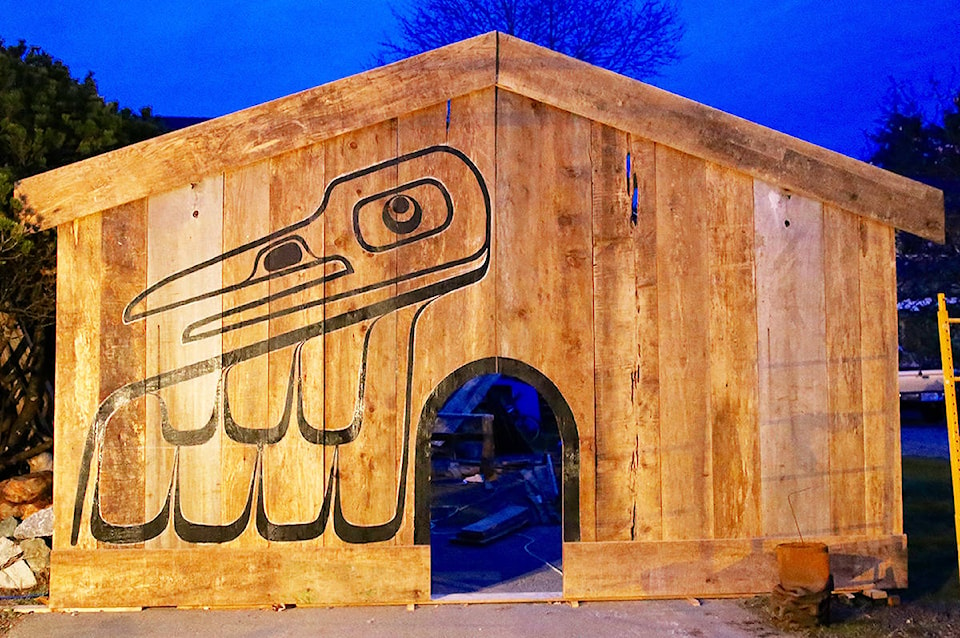Hjalmer Wenstob created a traffic-stopping stir in Ucluelet last week while working on his latest art installation.
The 24 year-old Ucluelet local and Tla-o-qui-aht First Nation member is wrapping up his Masters of Fine Arts degree at the University of Victoria and is putting the final touches on his project-based master’s thesis, which will be displayed in his graduating class’ final show, dubbed Pending Approval.
Wenstob has titled his installation ‘Transfigurations,’ and taken a unique step outside his medium to create seven hanging fabric pieces that mesh his traditional values with a contemporary premise.
Wenstob carved seven masks and hardened fabric overtop of each one. He then removed the fabric to create “this ghostly outline of the mask that was left behind.”
“I’m hanging them off lights so they become almost these kind of really visceral objects but they feel kind of like spirits in the space,” he said.
He hopes the effect will help capture a taste of powerful movements that can be lost when masks are hung or displayed behind glass.
“When I first started carving, I was carving dancing masks. I wasn’t carving masks to hang on the wall…You’re carving a part of yourself and you’re carving these dance masks that become alive when they’re danced at potlatches or ceremonies. They’re not art, they’re cultural objects,” he said. “When I think about masks, I don’t think about where they exist nowadays, where we see them in big art galleries in Vancouver and Victoria. I wanted to let everyone have a feeling of what these masks really are and what these dances really are. It’s a way of giving an echo of something; a feeling of that ceremony, without actually bringing you into the hall itself.”
To magnify the echo, Wenstob created a false-front of a longhouse and plans to drape black fabric around piping in the back to create a dark room for people to experience his work.
“When it came to showing these fabric pieces, I hung them up in the gallery; a big white room with lighting, that’s all it is, and they didn’t have the effect that they do in a potlatch,” he said. “When those dances are done, you feel it inside. You really feel it. So I decided they needed a space where they belong…This is going to be a way to bring our space into that contemporary space.”
Wenstob created the front from wooden boards taken from his family’s former longhouse on Tzartus Island.
“I was telling my grandad about this project and he said, ‘You have to take the boards from home…they need to be used again and live on to be another structure,’” he said.
He painted mirrored raven image’s on the front as a shout out to his childhood pet raven that, he said, still lives on Tzartus and greeted him when he arrived to pick up the longhouse boards.
“He was right there coming along and hopping along the beach and hanging out with us the whole time,” Wenstob said.
With his master’s degree soon to be in hand, Wenstob hopes to continue creating connections and inspiring education through his art and said he’s also focused on changing the landscape around how First Nations art is viewed.
“The only way people do see these objects is in museums. They see us as people of the past, stories of the past, but we’re still here now and we still dance those masks now,” he said.
“It’s, kind of, a way to let other people in, to know a little bit of home. I don’t want to be a politician, but I play politics all the time and I want to do it in a way that brings all people together…It’s a way to open the door and bring people in to talk about our culture and talk about who we are as people.”
He suggested Canada’s 150th birthday celebrations and Year of Reconciliation declaration has pushed important conversations to the forefront and he’s been pleased to see audiences become more engaged.
“It’s a time where people do really want to know our history. We’re at a lot of turning points in Canada,” he said.
“I don’t think I’ve met many racist people in my time, but a lot of people who are really ill-informed. Ignorance is alive and well in Canada…I think there’s a lot of work to do but, of course, I’m excited about the future. There’s so many people that really want to engage right now and so many people who want to learn right now that it’s a really great time.”
